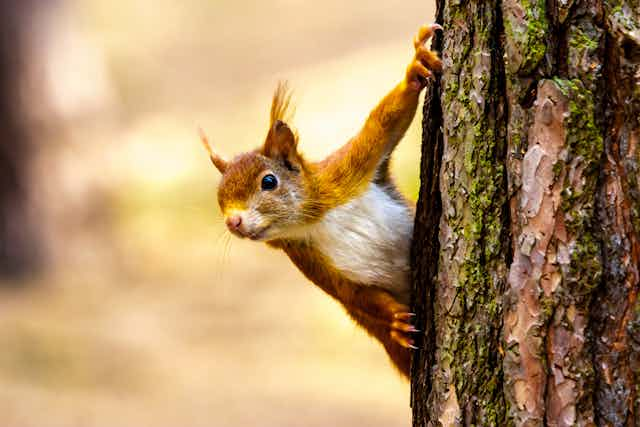By 2050, two thirds of the world’s population will live in an urban area. Until recently, we knew little about how wild animals were coping with the growth of all those towns and cities. The field of urban wildlife ecology has since emerged to fill this gap.
Urban ecologists have found some species, like Britain’s hedgehogs, have struggled to cope. But other species, often called “synurbic”, have proven themselves very adaptable and, in some cases, they can actually live at higher densities in cities.
One species capable of modern urban living is the red squirrel. Understanding how they behave in towns and cities, a topic that is relatively unexplored, could help their long-term conservation.
Red squirrels are found in cities right across mainland Europe, for example in Finland, France, and Poland. It is likely they were once also found in many UK towns too. However, Britain’s native squirrel is now a very rare sight, thanks to decades of habitat loss and the introduction of the larger and more competitive grey squirrel from North America.
A red stronghold
But one town where the reds haven’t disappeared is Formby, in Merseyside, the study site for my PhD researching the urban ecology of red squirrels. Formby is one of few red squirrel strongholds in England and one of the only remaining urban areas where they can be found at all.
Red squirrels can easily be spotted in gardens throughout the town. Local residents are passionate about protecting their unusual wildlife, with many of them providing supplemental food and volunteering locally with conservation organisations. These organisations manage the extensive woodland to the west of the town, where they supply additional food themselves, and employ dedicated “squirrel officers” who help maintain “grey squirrel-free” habitats.
In addition to the woodland, the town itself contains ideal habitat, with hedgerows and trees lining the roads and gardens, which provide corridors for the squirrels to move through. Urban areas also typically have fewer natural predators, such as buzzards.

Unfortunately, invasive grey squirrels like all these things too and, given the chance, they would colonise the town and displace the reds. However, a combination of grey squirrel control (including protection from their advances on one side by the sea), supplemental feeding, suitable urban green spaces, and careful monitoring by volunteers and rangers have meant that the reds have clung on in Formby, despite greys replacing them elsewhere in the UK.
The longer-term strategy is to manage the area in favour of the reds. This could involve, for example, planting trees which the reds can easily exploit but the greys are less able to, like native conifers and small-seeded broadleaved trees such as birch or ash. Greys instead prefer large-seeded broadleaves, such as oak and beech.
Urban hazards
However, there are downsides to living alongside people. For instance, several studies have flagged road traffic as the biggest cause of squirrel mortality. Despite fewer natural predators, there are higher numbers of pets, such as cats and dogs, that can injure and even kill squirrels. In addition, some of the trees in the town may be gradually lost as residents landscape their gardens, further fragmenting the remaining habitat.
Even the widespread supplemental feeding could have hidden negative consequences. In Formby, well-meaning residents provide lots of peanuts: one of the squirrels’ favourite foods. Unfortunately, peanuts are low in calcium and alone do not give the required nutrition that a squirrel needs.

If feeders are not cleaned thoroughly and regularly, this could also contribute to another outbreak of squirrelpox virus or other diseases. This suggests that residents, who are enthusiastic about feeding the squirrels (and should continue to do so), perhaps need to be provided with more information, such as on what to supply for a varied diet.
Urban management as a conservation tool
Much of the research and conservation of red squirrels in the UK is carried out in more rural areas, such as Kielder Forest in Cumbria, often along the interface with the invasive grey squirrel. However, managing urban sites for the benefit of the native reds could be a useful alternative conservation tool, through making the most of the benefits of living alongside people.
For example, local volunteers could act as a free and dedicated workforce for conserving and monitoring the red squirrels, as is the case in Formby. This could be employed in the nearby towns, or even elsewhere in Britain near squirrel strongholds, to hopefully encourage the reds to disperse and reoccupy areas as they become free from greys. This is currently occurring in Wales, with reds crossing over from the island of Anglesey onto the mainland as rangers remove greys from the area around nearby Bangor.
An urban management plan could also create the opportunity to develop more green spaces and wildlife-friendly gardens. This would benefit all of the local biodiversity, not only squirrels, as well as the people.
This is what my research aims to explore over the next few years: how have red squirrels adapted to urban life, and how do the associated resources and risks affect their ecology. By understanding this, we can hopefully develop a strategy to better protect this charming native species.

